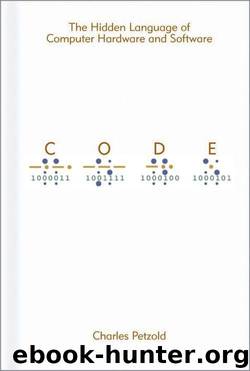CODE by Petzold Charles

Author:Petzold, Charles [Petzold, Charles]
Language: eng
Format: mobi, epub
Tags: COMPUTERS / Software Development & Engineering / General
Publisher: Microsoft Press
Published: 2009-11-29T16:00:00+00:00
Beginning about 1820, Babbage believed that he could design and build a machine that would automate the process of constructing a table, even to the point of setting up type for printing. This would eliminate errors. He conceived the Difference Engine, and basically it was a big mechanical adding machine. Multidigit decimal numbers were represented by geared wheels that could be in any of 10 positions. Negatives were handled using the ten's complement. Despite some early models that showed Babbage's design to be sound and some grants from the British government (never enough, of course), the Difference Engine was never completed. Babbage abandoned work on it in 1833.
By that time, however, Babbage had an even better idea. It was called the Analytical Engine, and through repeated design and redesign (with a few small models and parts of it actually built) it consumed Babbage off and on until his death. The Analytical Engine is the closest thing to a computer that the nineteenth century has to offer. In Babbage's design, it had a store (comparable to our concept of memory) and a mill (the arithmetic unit). Multiplication could be handled by repeated addition, and division by repeated subtraction.
What's most intriguing about the Analytical Engine is that it could be programmed using cards that were adapted from the cards used in the Jacquard pattern-weaving loom. As Augusta Ada Byron, Countess of Lovelace (1815–1852), put it (in notes to her translation of an article written by an Italian mathematician about Babbage's Analytical Engine), "We may say that the Analytical Engine weaves algebraical patterns just as the Jacquard-loom weaves flowers and leaves."
Babbage seems to be the first person to understand the importance of a conditional jump in computers. Here's Ada Byron again: "A cycle of operations, then, must be understood to signify any set of operations which is repeated more than once. It is equally a cycle, whether it be repeated twice only, or an indefinite number of times; for it is the fact of a repetition occurring at all that constitutes it such. In many cases of analysis there is a recurring group of one or more cycles; that is, a cycle of cycle, or a cycle of cycles."
Although a difference engine was eventually built by father-and-son team Georg and Edvard Scheutz in 1853, Babbage's engines were forgotten for many years, only to be resurrected in the 1930s when people began searching for the roots of twentieth century computing. By that time, everything Babbage had done had already been surpassed by later technology, and he had little to offer the twentieth century computer engineer except a precocious vision of automation.
Another milestone in the history of computing resulted from Article I, Section 2, of the Constitution of the United States of America. Among other things, this section calls for a census to be taken every ten years. By the time of the 1880 census, information was accumulated on age, sex, and national origin. The data amassed took about seven years to process.
Fearing that the
Download
This site does not store any files on its server. We only index and link to content provided by other sites. Please contact the content providers to delete copyright contents if any and email us, we'll remove relevant links or contents immediately.
| Coding Theory | Localization |
| Logic | Object-Oriented Design |
| Performance Optimization | Quality Control |
| Reengineering | Robohelp |
| Software Development | Software Reuse |
| Structured Design | Testing |
| Tools | UML |
Deep Learning with Python by François Chollet(11873)
Hello! Python by Anthony Briggs(9365)
OCA Java SE 8 Programmer I Certification Guide by Mala Gupta(9336)
The Mikado Method by Ola Ellnestam Daniel Brolund(9300)
Dependency Injection in .NET by Mark Seemann(8853)
Algorithms of the Intelligent Web by Haralambos Marmanis;Dmitry Babenko(7845)
Test-Driven iOS Development with Swift 4 by Dominik Hauser(7305)
Grails in Action by Glen Smith Peter Ledbrook(7291)
The Well-Grounded Java Developer by Benjamin J. Evans Martijn Verburg(7111)
Secrets of the JavaScript Ninja by John Resig Bear Bibeault(5951)
Kotlin in Action by Dmitry Jemerov(4633)
Practical Vim (for Kathryn Amaral) by Drew Neil(3724)
Cracking the GRE Premium Edition with 6 Practice Tests, 2015 (Graduate School Test Preparation) by Princeton Review(3590)
Linux Device Driver Development Cookbook by Rodolfo Giometti(3387)
Learn Windows PowerShell in a Month of Lunches by Don Jones(3236)
Learning Java by Patrick Niemeyer & Daniel Leuck(2867)
Learning React: Functional Web Development with React and Redux by Banks Alex & Porcello Eve(2830)
Becoming a Dynamics 365 Finance and Supply Chain Solution Architect by Brent Dawson(2574)
Mastering Java 9 by Dr. Edward Lavieri(2569)
